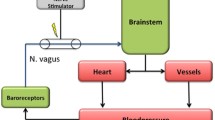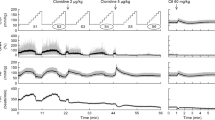Abstract
The ganglionic blocking agent trimethaphan (TMP) is no longer produced. Therefore, a need exists for alternative pharmacological approaches to investigate baroreflex control of the circulation. The aim of the present study was to examine baroreflex-mediated cardiovascular responses during the administration of a muscarinic receptor antagonist (glycopyrrolate; Gly) and a selective alpha-2 receptor agonist (dexmedetomidine; Dex) and to compare responses to ganglionic blockade with TMP. We hypothesized that combined Gly-Dex would inhibit the baroreflex similar to TMP. Ten volunteers participated in two study days and were instrumented with pulse oximeter, nasal cannula, ECG, continuous blood pressure monitoring (Finapres), and I.V. catheter for drug infusions. Each study day consisted of a control condition followed by either combined Gly–Dex or TMP on alternating days. A Valsalva maneuver was performed under each condition with every subject and six subjects received bolus phenylephrine (25 μg) during Gly–Dex and TMP. Combined Gly–Dex increased (P < 0.05) blood pressure (99 ± 4 mmHg) and heart rate (99 ± 3 bpm) relative to control condition (BP: 90 ± 2 mmHg; HR: 64 ± 3 bpm) and TMP infusion decreased (P < 0.05) blood pressure (79 ± 3 mmHg) while increasing heart rate (88 ± 3 bpm). Valsalva maneuver elicited a persistent drop in arterial pressure (no phase IIb recovery) with the absence of a phase IV overshoot during both Gly–Dex and TMP conditions. Phenylephrine increased systolic pressure 34 ± 4 mmHg under Gly–Dex and 23 ± 3 mmHg with TMP (P < 0.05). Heart rate only decreased 1 ± 2 bpm during Gly–Dex and 1 ± 1 bpm with TMP. Taken together, our results suggest that Gly–Dex is a reasonable alternative to TMP for baroreflex inhibition.




Similar content being viewed by others
References
Aantaa R, Jaakola ML, Kallio A, Kanto J, Scheinin M, Vuorinen J (1991) A comparison of dexmedetomidine, and alpha 2-adrenoceptor agonist, and midazolam as i.m. premedication for minor gynaecological surgery. Br J Anaesth 67:402–409
Arain SR, Ebert TJ (2002) The efficacy, side effects, and recovery characteristics of dexmedetomidine versus propofol when used for intraoperative sedation. Anesth Analg 95:461–466
Arain SR, Ruehlow RM, Uhrich TD, Ebert TJ (2004) The efficacy of dexmedetomidine versus morphine for postoperative analgesia after major inpatient surgery. Anesth Analg 98:153–158
Christou DD, Jones PP, Seals DR (2003) Baroreflex buffering in sedentary and endurance exercise-trained healthy men. Hypertension 41:1219–1222
Diedrich A, Jordan J, Tank J, Shannon JR, Robertson R, Luft FC, Robertson D, Biaggioni I (2003) The sympathetic nervous system in hypertension: assessment by blood pressure variability and ganglionic blockade. J Hypertens 21:1677–1686
Dinenno FA, Eisenach JH, Dietz NM, Joyner MJ (2002) Post-junctional alpha-adrenoceptors and basal limb vascular tone in healthy men. J Physiol 540:1103–1110
Ebert TJ, Hall JE, Barney JA, Uhrich TD, Colinco MD (2000) The effects of increasing plasma concentrations of dexmedetomidine in humans. Anesthesiology 93:382–394
Eckberg DL (1980) Parasympathetic cardiovascular control in human disease: a critical review of methods and results. Am J Physiol 239:H581–593
Ford GA, James OF (1994) Effect of ‘autonomic blockade’ on cardiac beta-adrenergic chronotropic responsiveness in healthy young, healthy elderly and endurance-trained elderly subjects. Clin Sci (Lond) 87:297–302
Freund BJ, Joyner MJ, Jilka SM, Kalis J, Nittolo JM, Taylor JA, Peters H, Feese G, Wilmore JH (1987) Thermoregulation during prolonged exercise in heat: alterations with beta-adrenergic blockade. J Appl Physiol 63:930–936
Gurbet A, Basagan-Mogol E, Turker G, Ugun F, Kaya FN, Ozcan B (2006) Intraoperative infusion of dexmedetomidine reduces perioperative analgesic requirements. Can J Anaesth 53:646–652
Hall JE, Uhrich TD, Barney JA, Arain SR, Ebert TJ (2000) Sedative, amnestic, and analgesic properties of small-dose dexmedetomidine infusions. Anesth Analg 90:699–705
Harioka T, Hatano Y, Mori K, Toda N (1984) Trimethaphan is a direct arterial vasodilator and an alpha-adrenoceptor antagonist. Anesth Analg 63:290–296
Jaakola ML, Salonen M, Lehtinen R, Scheinin H (1991) The analgesic action of dexmedetomidine–a novel alpha 2-adrenoceptor agonist–in healthy volunteers. Pain 46:281–285
Jones PP, Christou DD, Jordan J, Seals DR (2003) Baroreflex buffering is reduced with age in healthy men. Circulation 107:1770–1774
Jones PP, Shapiro LF, Keisling GA, Jordan J, Shannon JR, Quaife RA, Seals DR (2001) Altered autonomic support of arterial blood pressure with age in healthy men. Circulation 104:2424–2429
Jordan J, Shannon JR, Black BK, Lance RH, Squillante MD, Costa F, Robertson D (1998) N(N)-nicotinic blockade as an acute human model of autonomic failure. Hypertension 31:1178–1184
Katragadda S, Xie A, Puleo D, Skatrud JB, Morgan BJ (1997) Neural mechanism of the pressor response to obstructive and nonobstructive apnea. J Appl Physiol 83:2048–2054
Kivisto KT, Kallio A, Neuvonen PJ (1994) Pharmacokinetics and pharmacodynamics of transdermal dexmedetomidine. Eur J Clin Pharmacol 46:345–349
Korner PI, Tonkin AM, Uther JB (1976) Reflex and mechanical circulatory effects of graded Valsalva maneuvers in normal man. J Appl Physiol 40:434–440
Looga R (2005) The Valsalva manoeuvre–cardiovascular effects and performance technique: a critical review. Respir Physiol Neurobiol 147:39–49
Masuki S, Dinenno FA, Joyner MJ, Eisenach JH (2005) Selective {alpha}2-adrenergic properties of dexmedetomidine over clonidine in the human forearm. J Appl Physiol 99:587–592
Minson CT, Halliwill JR, Young TM, Joyner MJ (2000) Influence of the menstrual cycle on sympathetic activity, baroreflex sensitivity, and vascular transduction in young women. Circulation 101:862–868
Minson CT, Halliwill JR, Young TM, Joyner MJ (2000) Sympathetic activity and baroreflex sensitivity in young women taking oral contraceptives. Circulation 102:1473–1476
Muszkat M, Sofowora GG, Wood AJ, Stein CM (2004) Alpha2-adrenergic receptor-induced vascular constriction in blacks and whites. Hypertension 43:31–35
Robertson D, Johnson GA, Robertson RM, Nies AS, Shand DG, Oates JA (1979) Comparative assessment of stimuli that release neuronal and adrenomedullary catecholamines in man. Circulation 59:637–643
Robinson BF, Epstein SE, Beiser GD, Braunwald E (1966) Control of heart rate by the autonomic nervous system. Studies in man on the interrelation between baroreceptor mechanisms and exercise. Circ Res 19:400–411
Sandroni P, Benarroch EE, Low PA (1991) Pharmacological dissection of components of the Valsalva maneuver in adrenergic failure. J Appl Physiol 71:1563–1567
Shannon JR, Jordan J, Black BK, Costa F, Robertson D (1998) Uncoupling of the baroreflex by N(N)-cholinergic blockade in dissecting the components of cardiovascular regulation. Hypertension 32:101–107
Wray DW, Formes KJ, Weiss MS, Olivencia-Yurvati AH, Raven PB, Zhang R, Shi X (2001) Vagal cardiac function and arterial blood pressure stability. Am J Physiol Heart Circ Physiol 281:H1870–1880
Zhang R, Crandall CG, Levine BD (2004) Cerebral hemodynamics during the Valsalva maneuver: insights from ganglionic blockade. Stroke 35:843–847
Acknowledgments
The authors are grateful to the subjects who volunteered for this study. We also thank Pam Engrav, Shelly Roberts, Chris Johnson, and John Halliwill for their technical assistance. This research was supported by National Institutes of Health Grants HL-78019 (B.W. Wilkins), K23 RR-17520 (J.H. Eisenach), PPG NS-032352 (M.J. Joyner), GCRC RR-00585, and by the Deutsche Forschungsgemeinschaft DFG, He 4605/1-1 (C. Hesse), GM-08685 (W.T. Nicholson).
Author information
Authors and Affiliations
Corresponding author
Rights and permissions
About this article
Cite this article
Wilkins, B.W., Hesse, C., Sviggum, H.P. et al. Alternative to ganglionic blockade with anticholinergic and alpha-2 receptor agents. Clin Auton Res 17, 77–84 (2007). https://doi.org/10.1007/s10286-006-0387-7
Received:
Accepted:
Published:
Issue Date:
DOI: https://doi.org/10.1007/s10286-006-0387-7




